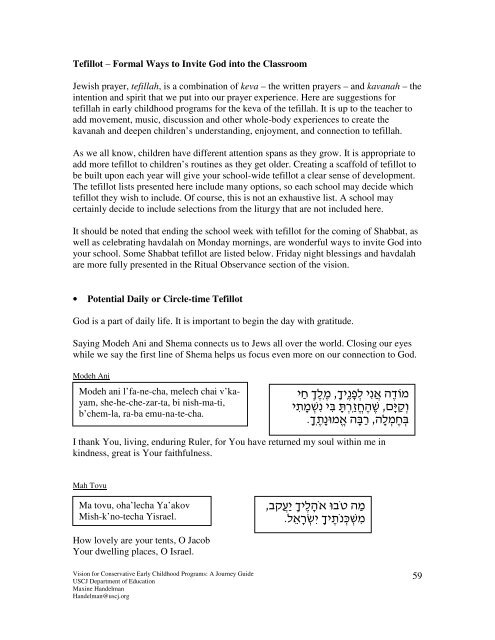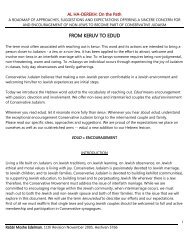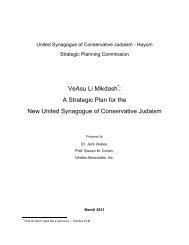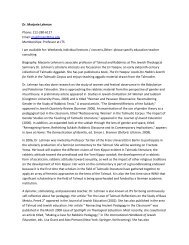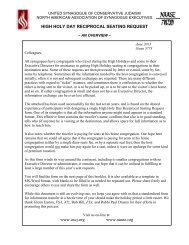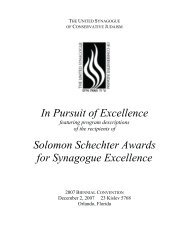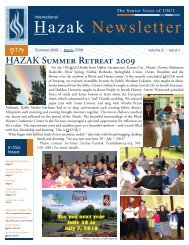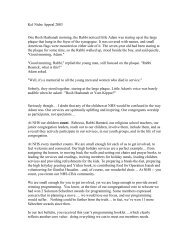Vision for Conservative Early Childhood Programs: A Journey Guide
Vision for Conservative Early Childhood Programs: A Journey Guide
Vision for Conservative Early Childhood Programs: A Journey Guide
Create successful ePaper yourself
Turn your PDF publications into a flip-book with our unique Google optimized e-Paper software.
Tefillot – Formal Ways to Invite God into the Classroom<br />
Jewish prayer, tefillah, is a combination of keva – the written prayers – and kavanah – the<br />
intention and spirit that we put into our prayer experience. Here are suggestions <strong>for</strong><br />
tefillah in early childhood programs <strong>for</strong> the keva of the tefillah. It is up to the teacher to<br />
add movement, music, discussion and other whole-body experiences to create the<br />
kavanah and deepen children’s understanding, enjoyment, and connection to tefillah.<br />
As we all know, children have different attention spans as they grow. It is appropriate to<br />
add more tefillot to children’s routines as they get older. Creating a scaffold of tefillot to<br />
be built upon each year will give your school-wide tefillot a clear sense of development.<br />
The tefillot lists presented here include many options, so each school may decide which<br />
tefillot they wish to include. Of course, this is not an exhaustive list. A school may<br />
certainly decide to include selections from the liturgy that are not included here.<br />
It should be noted that ending the school week with tefillot <strong>for</strong> the coming of Shabbat, as<br />
well as celebrating havdalah on Monday mornings, are wonderful ways to invite God into<br />
your school. Some Shabbat tefillot are listed below. Friday night blessings and havdalah<br />
are more fully presented in the Ritual Observance section of the vision.<br />
• Potential Daily or Circle-time Tefillot<br />
God is a part of daily life. It is important to begin the day with gratitude.<br />
Saying Modeh Ani and Shema connects us to Jews all over the world. Closing our eyes<br />
while we say the first line of Shema helps us focus even more on our connection to God.<br />
Modeh Ani<br />
Modeh ani l’fa-ne-cha, melech chai v’kayam,<br />
she-he-che-zar-ta, bi nish-ma-ti,<br />
b’chem-la, ra-ba emu-na-te-cha.<br />
! <br />
<br />
% & '(! " # $<br />
( % ! %<br />
I thank You, living, enduring Ruler, <strong>for</strong> You have returned my soul within me in<br />
kindness, great is Your faithfulness.<br />
Mah Tovu<br />
Ma tovu, oha’lecha Ya’akov<br />
Mish-k’no-techa Yisrael.<br />
<br />
<br />
<br />
<br />
How lovely are your tents, O Jacob<br />
Your dwelling places, O Israel.<br />
<strong>Vision</strong> <strong>for</strong> <strong>Conservative</strong> <strong>Early</strong> <strong>Childhood</strong> <strong>Programs</strong>: A <strong>Journey</strong> <strong>Guide</strong><br />
USCJ Department of Education<br />
Maxine Handelman<br />
Handelman@uscj.org<br />
59


